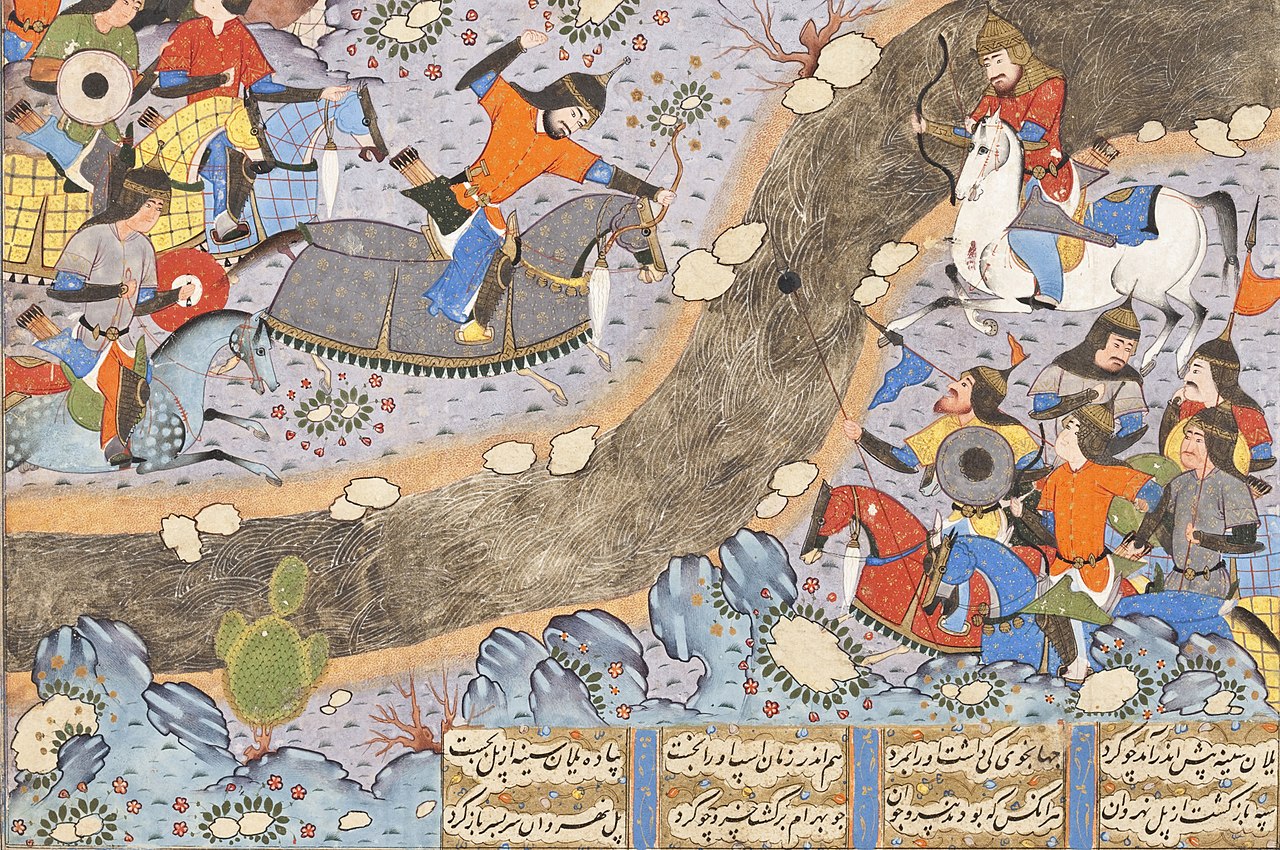The untrustworthy birdhawn of King Khosrow
Today I read Hisham Ibn al-Kalbi’s (d. 819 CE) “Horse Lineages in the Jahiliyyah and Islam” from cover to cover. It is a a quick read, and the earliest of the Arabic books on horses. I was looking for specific things, but I found this fascinating story, about a specific horse named al-Dubayb. My translation:
Al-Dubayb: the horse of Hassaan ibn Hanzhalah al-Taa’i. He carried Khosrow Anushirvan [on his back] when he [i.e., Khosrow] was defeated by Bahram Chobin, so he [i.e., Khosrow] survived. And there was a long story about him. So Hassaan ibn Hanzhalah recited:
“I avoided Khosrow being trounced; I was not going // to leave him looking for a horse on foot!
I offered him the chest of al-Dubayb // as the mare of the Turks and Kabul went off”
Khorsow’s birdhawn had reared and thrown him. When his reign stabilized, Hassaan came to see him [i.e., see Khosrow], and he [i.e., Khosrow] granted him the district [tassuj] of Khutarnia.
This amazing story relates how Hassaan ibn Hanzhalah, an Arab knight from the tribe of Tay in the army of Sassanian Persian King Khorsow, saved the king in battle by putting him on his horse and was later rewarded for it. The King is actually Khosrow II Parviz (the Victorious), not Khosrow I Anushirvan as in Ibn al-Kalbi’s story. Khosrow II indeed fought a rebellion by Parthian nobleman Bahram Chobin, who briefly became king in 590 CE under the name of Bahram VI. Khosrow was able to regain his kingship within a year. Khutarnia is an area by the Sassanian capital Ctesiphon, close to Babylon, in Iraq. A tassuj is an administrative sub-district in the Middle Persian language.

Persian miniature from a later date.
So according to the knight/poet who saved his life, King Khosrow was mounted on a mare from the horses of the Turks and Kabul [musawwamatun min khayli Turkin wa Kabul]. The term musawwamah means that the mare was marked or adorned in some way. Ibn al-Kalbi added that this mare had reared and thrown the King to the ground, and referred to her as a birdhawn.
If the verse relating the story was contemporaneous with the events described, it would mean that, by 600 CE, hence before the rise of Islam, Hassaan was already aware that his horse al-Dubayb was somehow different from the Turkish/Khurasanian horse the Persian king was riding in battle. Kabul was then part of Khurasan.
If the verse was composed at a later period, after the advent of Islam, and retro-attributed to a pre-Islamic poet, it would then mean that Turkish and Khurasani horses were already being characterized as birdhawn by the time of Hisham ibn al-Kalbi (737-819 CE). Arab-Persian rivalry in the early Abbasid Caliphate was already festering when Ibn al-Kalbi was writing. This very explicit verse — and the entire story it illustrates for that matter — may have served the political purpose of reminding the rising Persian majority of the debt they owed to the Arab ruling minority (“Come on, we were not going to let that king lie on the ground!”). That both the Arabs and most of the Persians were Muslim by then did not matter much. The verse may have also served a secondary purpose: to make a point about the superiority of the war horses of the Arabs over those of the Persians and the Turks: untrustworthy Turkish/Khurasani horses throw kings and run away from the battleground, while the horses of the Arabs face danger and bravely rescue them.
Finally, note that Ibn al-Kalbi used the term birdhawn to designate a Turkish/Khurasani horse ridden by a king and used as a war horse. No humble pack animal here.
Next, I want to find more about the term musawwamah.
This is fascinating reading. So birdhawn is in use by the eighth century to designate horses of Turkish/Khurasanian origin; it indicates a riding horse and not a pack horse in this particular story. Hassaan’s horse al-Dubayb was not classified as a birdhawn, and in the story deemed to be more reliable than the king’s own mount, possibly for reasons of political/ethnic rivalry.
I love this all so much – there’s the apparent shift in meaning of birdhawn over time, the contrast between Hassaan’s horse and the Turkish/Khurasanian mare – just little fragments of evidence that the Arabs saw their own horses as distinct from and better than those of other people.
@ Kate: yes the shift is very interesting! Ibn al Kalbi plays an important role in creating a history for the Arab identity, and retrojects various things into jahiliyyah. This entire book on horses is written to show the arab connection to the horse, however he doesnt use Arab as an adjective to horse in this work (which is surprising since earlier writers that he quotes sometimes do).
We have already seen in other fragments that birdhawn are identified as packhorses, but we can all imagine that one can ride those too, in fact ive cited a lexicon entrance in which the birdhawn was ridden too. (think the donkeys in current egypt who deliver horsefeed and are being ridden back home ) There is a fine line between riding horse and other jobs, and birdhawn may be used to classify riding horses, as sometimes it says faras birdhawn… a riding horse that is birdhawn.
I dont believe we have come to a definite definition yet…
the position of khurasan is very interesting. The texts sometimes express negativity, but many of the important early islamic scholars were ethnically from Khurasan. In current Khurasan people claim asil status for their horses 😉
Ibn al-Kalbi indeed calls them “Khuyul al-Arab” = “the horses of the Arabs”. He does quote al-Waqidi who calls them in another book “Khuyulihim al-‘Arabiyyah” = their Arab horses.